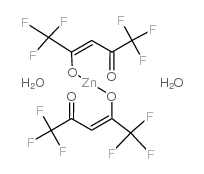16743-33-2
| Name | zinc,1,1,1,5,5,5-hexafluoro-4-oxopent-2-en-2-olate,dihydrate |
|---|---|
| Synonyms |
MFCD00150577
Hexafluoroacetylacetone zinc derivative zinc(II) bis(hexafluoroacetylacetonate)dihydrate |
| Boiling Point | 114.1ºC at 760mmHg |
|---|---|
| Melting Point | 157-158ºC |
| Molecular Formula | C10H6F12O6Zn |
| Molecular Weight | 515.51200 |
| Flash Point | 22.8ºC |
| Exact Mass | 513.92600 |
| PSA | 71.06000 |
| LogP | 3.95870 |
| Vapour Pressure | 10.3mmHg at 25°C |
|
Section 1: Product Identification Chemical Name:Zinc hexafluoroacetylacetonate hydrate, min. 98% CAS Registry Number:16743-33-2 Formula:Zn(CF3COCHCOCF3)2.2H2O EINECS Number:None Chemical Family:metal fluorobeta-diketonate complexes Synonym:Zinc hexafluoro 2,4-pentanedionate
Section 2: Composition and Information on Ingredients IngredientCAS NumberPercentACGIH (TWA)OSHA (PEL) Title Compound16743-33-2100%2.5mg/m3 (as F)2.5mg/m3 (as F) Section 3: Hazards Identification Irritating to skin, eyes and respiratory tract. Inhalation of high levels may produce symptoms known as metal Emergency Overview: fume fever or zinc shakes. These include chills, fever, nausea, and vomiting. Primary Routes of Exposure:Ingestion, Inhalation of dust. Eye Contact:Causes slight to mild irritation of the eyes. Skin Contact:Causes slight to mild irritation of the skin. Irritating to the nose, mucous membranes and respiratory tract. Inhalation may produce symptoms known as Inhalation: metal fume fever and zinc shakes. Ingestion:Zinc salts have a harsh metallic taste. Inhalation of dust may cause chills, muscle ache, nausea, fever, dry throat, cough; headache; blurred vision; Acute Health Affects: low back pain; vomiting; dyspnea (breathing difficulty), rales, and decreased pulmonary function Prolonged or repeated exposure may cause breathing difficulty and decreased pulmonary function. In animal Chronic Health Affects: studies mutagenic and reproductive effects were observed after prolonged exposures to zinc oxide dust. NTP:No IARC:No OSHA:No SECTION 4: First Aid Measures Immediately flush the eyes with copious amounts of water for at least 10-15 minutes. A victim may need Eye Exposure: assistance in keeping their eye lids open. Get immediate medical attention. Wash the affected area with water. Remove contaminated clothes if necessary. Seek medical assistance if Skin Exposure: irritation persists. Remove the victim to fresh air. Closely monitor the victim for signs of respiratory problems, such as difficulty Inhalation: in breathing, coughing, wheezing, or pain. In such cases seek immediate medical assistance. Seek medical attention immediately. Keep the victim calm. Give the victim water (only if conscious). Induce Ingestion: vomiting only if directed by medical personnel. SECTION 5: Fire Fighting Measures Flash Point:not applicable Autoignition Temperature:none Explosion Limits:none Extinguishing Medium:carbon dioxide, foam or dry powder If this product is involved in a fire, fire fighters should be equipped with a NIOSH approved positive pressure Special Fire Fighting Procedures: self- contained breathing apparatus and full protective clothing. Hazardous Combustion andIf involved in a fire this material may emit toxic and corrosive fumes. Decomposion Products: Unusual Fire or Explosion Hazards: No unusual fire or explosion hazards. SECTION 6: Accidental Release Measures Small spills can be mixed with vermiculite, sodium carbonate or other suitable non combustible adsorbent and Spill and Leak Procedures: swept up. SECTION 7: Handling and Storage Handling and Storage:Store in a cool, dry place in a tightly sealed container. SECTION 8: Exposure Controls and Personal Protection Eye Protection:Always wear approved safety glasses when handling a chemical substance in the laboratory. Skin Protection:Wear protective clothing and gloves. Ventilation:Material may form a fine dust. If possible, handle the material in an efficient fume hood. If ventilation is not available a respirator should be worn. The use of respirators requires a Respirator Respirator: Protection Program to be in compliance with 29 CFR 1910.134. Ventilation:Material may form a fine dust. If possible, handle the material in an efficient fume hood. Additional Protection:No additional protection required. SECTION 9: Physical and Chemical Properties Color and Form:white pwdr. Molecular Weight:479.47 (515.50) Melting Point:157-158°C Boiling Point:no data Vapor Pressure:no data Specific Gravity:no data Odor:none Solubility in Water:insoluble SECTION 10: Stability and Reactivity Stability:air and moisture stable Hazardous Polymerization:no hazardous polymerization Conditions to Avoid:none Incompatibility:Oxidizing agents Decomposition Products:Fluorinated organics, carbon dioxide, carbon monoxide, organic fumes, and zinc oxide. SECTION 11: Toxicological Information RTECS Data:No information available in the RTECS files. Carcinogenic Effects:No data Mutagenic Effects:No data Tetratogenic Effects:No data SECTION 12: Ecological Information Ecological Information:Very toxic to aquatic organisms. SECTION 13: Disposal Considerations Disposal:Dispose of according to local, state and federal regulations. SECTION 14: Transportation Shipping Name (CFR):Non-hazardous Hazard Class (CFR):NA Additional Hazard Class (CFR):NA Packaging Group (CFR):NA UN ID Number (CFR):NA Shipping Name (IATA):Non-hazardous Hazard Class (IATA):NA Additional Hazard Class (IATA):NA Packaging Group (IATA):NA UN ID Number (IATA):NA SECTION 15: Regulatory Information TSCA:Not listed in the TSCA inventory. SARA (Title 313):Title compound: See category N982 for reporting. Second Ingredient:None SECTION 16 - ADDITIONAL INFORMATION N/A |
| Symbol |

GHS07 |
|---|---|
| Signal Word | Warning |
| Hazard Statements | H315-H319-H335 |
| Precautionary Statements | P261-P305 + P351 + P338 |
| Personal Protective Equipment | dust mask type N95 (US);Eyeshields;Gloves |
| Hazard Codes | Xi: Irritant; |
| Risk Phrases | R36/37/38 |
| Safety Phrases | 26-36 |
| RIDADR | UN 3261 |
